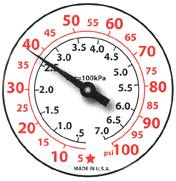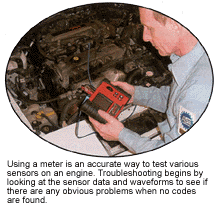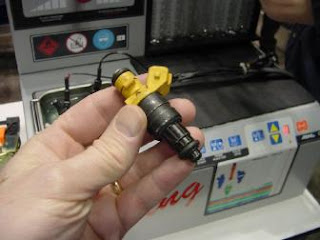Hesitation is when your engine misfires, stumbles or lacks power when you accelerate or step on the throttle. The problem often means the air/fuel mixture is not being properly enriched or is going lean, or the ignition system is weak and is misfiring when the engine comes under load or the air/fuel mixture goes lean. When you step down on the accelerator and the throttle opens, the engine sucks in more air. The computer should respond by adding more fuel.
If the engine has a speed-density type of fuel injection system (no airflow sensor), the computer uses inputs from the throttle position sensor, manifold absolute pressure sensor, air temperature sensor and engine rpm to estimate airflow and how much fuel the engine needs. NOTE: Speed-density systems are much less sensitive to vacuum leaks than EFI systems that use an airflow sensor. If the engine has an airflow sensor (vane airflow or mass airflow), it looks primarily at the airflow signal from the airflow sensor, but also takes into account what the throttle position sensor and MAP sensor (if equipped) are telling it. NOTE: Airflow EFI systems are very sensitive to vacuum leaks, and air leaks downstream of the airflow sensor. Consequently, if the inputs from any of these sensors is inaccurate or missing, the engine computer may not add enough fuel, allowing the fuel mixture to go lean causing a misfire that produces a hesitation or stumble when accelerating or opening the throttle. The amount of fuel added by the computer when the throttle opens may also be insufficient if the fuel injectors are dirty or fuel pressure is low. The oxygen sensors in the exhaust monitor the air/fuel mixture so the computer can adjust fuel trim as needed to maintain the proper air/fuel ratio. Fuel trim adjustments can compensate for dirty injectors and/or low fuel pressure to a certain extent, but occur too slowly to offset a throttle hesitation problem. Vacuum leaks will typically cause the fuel trim to run rich as the computer tries to compensate for the extra air being sucked into the engine through the leak. Possible Causes of Engine Hesitation or Stumble: * Dirty fuel injectors (cleaning the injectors often fixes this). * Bad MAP (manifold absolute pressure) sensor * Bad TPS (throttle position) sensor * Bad or dirty MAF (mass airflow) sensor * Low fuel pressure (leaky fuel pressure regulator, weak fuel pump or low system voltage or charging voltage that causes the fuel pump to run slow) * Vacuum leaks (intake manifold, vacuum hoses, throttle body, EGR valve) * Bad gasoline (fuel contaminated with water or too much alcohol) Sometimes, what feels like a hesitation is actually ignition misfirerather than lean misfire. The causes of ignition misfire may include: * Dirty or worn spark plugs * Bad plug wires * Weak ignition coil * Wet plug wires
A scan tool that can display sensor data and fuel trim values can help you diagnose a hesitation problem.
Plug your scan tool into the diagnostic connector and start the engine, then look at the Short Term Fuel Trim (STFT) and Long Term Fuel Trim (LTFT) values. Normal range is typically plus or minus 8. If the numbers are +10 or higher for STFT and LTFT, the engine is running LEAN. If you rev the engine to 1500 to 2000 rpm and hold it for a minute or so, and the STFT value drops back down to a more normal reading, it confirms the engine has a vacuum leak at idle. If the STFT value does not change much, the lean fuel condition is more likely a fuel delivery problem (weak fuel pump, restricted fuel filter, dirty fuel injectors or a leaky fuel pressure regulator) than a vacuum leak. For more information about using fuel trim to diagnose a lean fuel condition, read this article on Fuel Trim by Wells Manufacturing (PDF file, requires Adobe Acrobat to read). DIAGNOSTIC TIPS FOR P0171 OR P0174 LEAN TROUBLE CODES A code P0171 or P0174 (or both) indicate the engine is running lean. This means there is too much air and/or not enough fuel. If you have a scan tool that can display Short Term Fuel Trim (STFT), you can confirm the engine is running lean by looking at the STFT at idle. If STFT is greater than about 10 to 12, the engine is running LEAN. Increase engine speed to 1600 to 2000 rpm and hold for a minute or so, then recheck the STFT value. If it has dropped 3 or 4 points or more, the lean problem is due to a vacuum leak (vacuum leaks have more of an impact on the idle fuel mixture than the cruise mixture). If the STFT valve is still the same, the problem is probably sensor-related (dirty or bad MAF sensor, or bad MAP sensor), or is due to low fuel pressure. The next steps would be to use the scan tool to look at the airflow and MAP sensor readings, and to check fuel pressure. A lean fuel condition can be caused by: * Low fuel pressure due to a weak pump or leaky fuel pressure regulator. (use a fuel pressure gauge to check fuel pressure at idle) * Dirty fuel injectors. (try cleaning the injectors) * Vacuum leaks at the intake manifold, vacuum hose connections or throttle body. (Check for vacuum leaks) * Leaky EGR valve. (Check the operation of the EGR valve) * Leaky PCV Valve or hose. (Check valve and hose connections) * Dirty or defective Mass Airflow Sensor (MAF). (Try cleaning the MAF sensor wires or filament with aerosol electronics cleaner. Do NOT use anything else to clean the sensor, and do not touch the sensor wires) * TIP: On many Fords, a P0171 and/or P0174 Lean Code may sometimes appear because of a bad Differential Pressure Sensor (DPFE). This sensor monitors EGR flow, and is located on the engine near the EGR valve. There are two hoses that connect the sensor to the tube that runs from the exhaust manifold to the EGR valve. The sensor misreads EGR flow and the computer increases EGR which has a leaning effect on the fuel mixture. The fix is to replace the DPFE sensor. * TIP: For information about other causes of P0171 and P0174 lean codes on Ford Windstar, Click Here REPAIRS Repairs will depend on what is causing the hesitation. If the cause is fuel related, it may require cleaning the fuel injectors or fixing a vacuum leak. If the cause is ignition related, it may require replacing the spark plugs and plug wires.
If the engine has a speed-density type of fuel injection system (no airflow sensor), the computer uses inputs from the throttle position sensor, manifold absolute pressure sensor, air temperature sensor and engine rpm to estimate airflow and how much fuel the engine needs. NOTE: Speed-density systems are much less sensitive to vacuum leaks than EFI systems that use an airflow sensor. If the engine has an airflow sensor (vane airflow or mass airflow), it looks primarily at the airflow signal from the airflow sensor, but also takes into account what the throttle position sensor and MAP sensor (if equipped) are telling it. NOTE: Airflow EFI systems are very sensitive to vacuum leaks, and air leaks downstream of the airflow sensor. Consequently, if the inputs from any of these sensors is inaccurate or missing, the engine computer may not add enough fuel, allowing the fuel mixture to go lean causing a misfire that produces a hesitation or stumble when accelerating or opening the throttle. The amount of fuel added by the computer when the throttle opens may also be insufficient if the fuel injectors are dirty or fuel pressure is low. The oxygen sensors in the exhaust monitor the air/fuel mixture so the computer can adjust fuel trim as needed to maintain the proper air/fuel ratio. Fuel trim adjustments can compensate for dirty injectors and/or low fuel pressure to a certain extent, but occur too slowly to offset a throttle hesitation problem. Vacuum leaks will typically cause the fuel trim to run rich as the computer tries to compensate for the extra air being sucked into the engine through the leak. Possible Causes of Engine Hesitation or Stumble: * Dirty fuel injectors (cleaning the injectors often fixes this). * Bad MAP (manifold absolute pressure) sensor * Bad TPS (throttle position) sensor * Bad or dirty MAF (mass airflow) sensor * Low fuel pressure (leaky fuel pressure regulator, weak fuel pump or low system voltage or charging voltage that causes the fuel pump to run slow) * Vacuum leaks (intake manifold, vacuum hoses, throttle body, EGR valve) * Bad gasoline (fuel contaminated with water or too much alcohol) Sometimes, what feels like a hesitation is actually ignition misfirerather than lean misfire. The causes of ignition misfire may include: * Dirty or worn spark plugs * Bad plug wires * Weak ignition coil * Wet plug wires
DIAGNOSE ENGINE HESITATION PROBLEM
Diagnose may require checking the engine computer with a scan tool for any fault codes (including misfire codes), checking sensor response with a scan tool by looking at the various sensor PIDS (sensor values displayed on the scan tool), and testing sensors with a DVOM or scope if the values are out of range or the sensor is not responding normally. Additional diagnostic checks may include searching for vacuum leaks, inspecting/cleaning the EGR valve, measuring fuel pressure and volume, removing and inspecting the spark plugs, etc.
You can use a scan tool to check the fuel trim readings to see if the engine is running lean. Lean mixtures that are caused by vacuum leaks will have the most noticeable effect at idle. At part and full throttle, there is so much air entering the engine that a little extra air from a vacuum leak has a negligible effect.



















